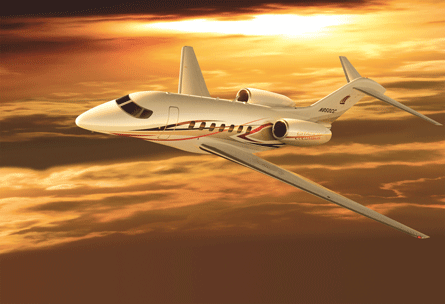Cessna has already sold 36 Model 850 Citation Columbus business jets – even though the first aircraft won’t be delivered for six years. “That’s 36 firm orders with non-refundable deposits,” says Doug Oliver, director of communications. “We had more than 100 refundable deposits for preferred positions before we announced it.”
The cabin mock-up is here in the static park at EBACE giving European buyers the opportunity to see first hand what the new flagship is all about.
Its max cruise speed of Mach 0.85 may not beat the Citation X, but the Columbus does boast a range of 4,000nm, or 33% farther than the Citation X. That’s further than Paris to New York or London to Dubai.

The aircraft has evolved from Cessna’s large cabin concept. At $27 million it’s easily at the top of Cessna’s price range and in the neighborhood of its competitors, the Dassault Falcon 2000EX and Challenger 605.
The Model 850 Citation Columbus’ cabin is more slender than these two rivals, but it is longer and virtually the same height. Clever adjustments to exterior ferrings were just one trick of senior project engineer Jon Carr. He led engineering of Cessna’s successful Mustang, and has now managed to squeeze the cabin floor lower in the fuselage than normal.
As opposed to running the floor across a much wider section of the fuselage, says Columbus program manager Joe Hepburn, “We can take the floor and put it down a little further and still span the distance with the method we’ve chosen.” Hepburn is 1.85m tall, but standing upright there is a 10mm clearance between the top of his head and the aisle ceiling. “I should have a little bit of clearance above my head to pass beneath the headliner,” he says.
The project is far from over. Preparation began in 2002 and exhaustive market research helped shape its configuration right up to this year. The 10-seat intercontinental jet should first fly in 2011, Hepburn says, with certification in 2012 and first customer delivery in 2014. That means a brand new manufacturing facility at Cessna’s Wichita, Kansas headquarters will need to be built by 2012. That means 1,000 jobs and an annual payroll of $74m will follow a $780m investment. In April the state of Kansas pledged $33m in bonds to help build that facility.
It’s an aluminum aircraft, like Cessna’s entire product line. “We plan to manufacture it in much the same process as we do with our previous products,” Hepburn says. No wing supplier has been chosen yet, he adds, but Wichita-based Spirit AeroSystems will produce the fuselage and empennage and Parker Aerospace’s Control Systems Division will supply the powered flight control system. It will be the first in the Citation family equipped with a hybrid fly-by-wire flight control system developed by Cessna.
Customers have not yet picked their avionics suite, but Hepburn expects the optional head-up display with enhanced vision to be “a high-penetration option” on the standard Collins Pro Line Fusion system.
The final choices may be different, he adds. “We’ve been watching the future regulatory environment to make sure we have a path to update our specs and our environment,” he says. Cessna is prepared to go in several directions. “We’re committed to looking at that many times between now and first delivery.”
Derivatives of the Columbus may have even more changes, possibly producing a super mid-size business jet not currently offered by Cessna. CEO and chairman Jack Pelton says the Columbus is the first of a family, with variants planned.
The target customer, as always with the Citation, is private owners or corporations, says Oliver. “The airplane does appear to be a good fit for fractional-type operation use, but as of right now, our business model is based on a traditional corporate aircraft flight department structure,” he says.
There are no fleet orders, Oliver says, and certainly no plans to pack in more seats than the 10 offered today. Hepburn says: “In an economy-class airliner you might be able to fit 25 people in that same area. There are a few who would like to understand if that were possible, but not the vast majority. There are additional regulations for going above ten passengers in the cabin that have to do with aisle width and emergency egress that would make it less than efficient to do more than that,” he explains.
Cessna engineers expect the Columbus to take off from runways of 5,400 feet (1,646 m), and climb in 27 minutes to 41,000ft (12,497 m). They’re aiming for a maximum altitude of 45,000ft (13,716m).
The twin Pratt & Whitney PW810 turbofan engines and the 8,830lb of thrust each produces will not be carrying a demo Columbus to EBACE for at least three years, but don’t be surprised to see more than a few orders this week in Geneva.
Flight's ACAS Buisness Aviation
Flight's 2008 pocket guide to business aircraft
For blogs, video, pictures, and more news from EBACE 2008, click here.
More news from EBACE 2008
Source: Flight Daily News























